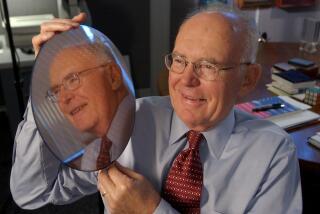Kenneth Olsen dies at 84; co-founder of Digital Equipment Corp.
- Share via
Kenneth Olsen, a computer industry pioneer and co-founder of Digital Equipment Corp., died Sunday. He was 84.
His death was announced by Gordon College in Wenham, Mass., where he was a trustee and benefactor. No other details were given.
DEC, which Olsen launched in 1957, is considered an icon in technology circles today. The company attracted top engineers and helped usher in a technology revolution that changed the way people interact with computers.
In the 1960s and 1970s, DEC played a central role in creating the market for “minicomputers,” powerful, refrigerator-sized machines that appealed to scientists, engineers and other number crunchers who did not need the bigger, multimillion-dollar mainframes used by big corporations. At its peak in the 1980s, DEC was the second-largest computer maker behind IBM.
“It’s too easy to forget that it was Ken Olsen’s vision of interactivity that took computing away from the centralized mainframe and into the hands of the people,” said Gordon Bell, who joined DEC in 1960 and headed the company’s engineering operations for more than 20 years.
Ultimately, DEC lost its way in the Internet-era transformations of the technology industry, which shrank computers down to pocket-sized gadgets. And Olsen is still remembered for his 1977 prediction that “there is no reason for any individual to have a computer in their home.” He later insisted the quote was taken out of context and that he simply meant he could not envision a day when computers would run people’s lives.
Olsen was born Feb. 20, 1926, in Bridgeport, Conn. His father designed machine tools and Olsen and his brothers spent hours tinkering with gadgets in the family basement. During World War II, Olsen attended the Navy’s electronics school. He later earned bachelor’s and master’s degrees in engineering from the Massachusetts Institute of Technology.
At MIT, Olsen worked in the university’s Lincoln Laboratory, a research center created to develop technology to improve the nation’s air defense system. That technology grew into the Air Force’s Semi-Automatic Ground Environment defense system, which was used to track and intercept enemy aircraft. One of Olsen’s roles at Lincoln Laboratory was to serve as a liaison with IBM, a major contractor on the project. Olsen also worked on Lincoln Lab’s TX-2 computer, which helped break new ground in computer-aided drafting.
In 1957, Olsen teamed with MIT colleague Harlan Anderson to start Digital Equipment Corp. in Maynard, Mass. DEC named its first computer the PDP-1, for Programmed Data Processor. But it was the PDP-8, which was introduced in 1965 and became a building block for computer systems made by other companies, that really established minicomputers as a major new industry.
The PDP-11 — and later DEC’s Virtual Address eXtension, or VAX, series — offered a serious alternative to IBM’s central mainframe approach. Digital was also a pioneer in the use of networking technology to link its computers together.
DEC’s innovations made their machines accessible to small and medium-sized operations and even individual users.
“The computers we built were of a cost and size that they brought computing down a level,” said Bell, now a principal researcher in Microsoft Corp.’s Silicon Valley Research Group.
DEC computers also trained and influenced many key players in the technology industry. Microsoft co-founders Bill Gates and Paul Allen used the PDP-10 to create the first version of the BASIC programming language for a personal computer. Dave Cutler, who developed several key operating systems for DEC, went on to develop the Windows NT and Azure operating systems for Microsoft.
For many years, the company’s sophisticated technology drove rapid corporate growth and inspired deep loyalty.
In 1986, Fortune Magazine called Olsen “America’s most successful entrepreneur.” By the late 1980s, DEC had more than 120,000 employees worldwide. Sales peaked at $14 billion in 1992.
Digital’s fortunes had begun to decline by the early 1990s. The company was late to recognize the growing popularity of smaller personal computers and desktop workstations for business use.
Even as DEC tried to catch up with new products, including a line of personal computers, it never regained its footing. The company posted its first quarterly loss in 1990. Faced with struggling product lines, Olsen started cutting Digital’s workforce through buyouts, early retirements and layoffs.
In 1992, Olsen left the company at the request of the board. In 1998, Compaq Computer Corp. bought what was left of DEC for $9.6 billion. Four years later, Compaq and the remnants of DEC were acquired by Hewlett-Packard Co.
More to Read
Start your day right
Sign up for Essential California for the L.A. Times biggest news, features and recommendations in your inbox six days a week.
You may occasionally receive promotional content from the Los Angeles Times.





